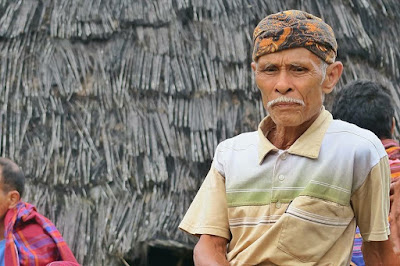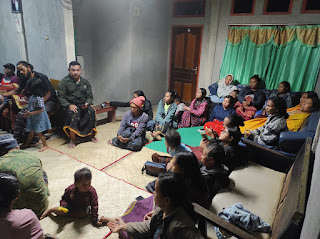"Tapa Kolo" The tradition of cooking rice using bamboo.
Wakos village never stops
presenting me with new stories, knowledge and experiences of Manggarai-Flores
traditions, rituals and culture in every journey I go through. A recent visit
led me to a big family that seems to be united in various occasions and who
have become very special to me.
Fresh leaves from the palm
tree ("leka" in the Manggarai language), fragrant Pandan leaves,
bamboo stems, and of course rice are the main materials used in preparing tapa
kolo.
The bamboo that was cut has to be very selectively
chosen, of a certain age and size. According to Bapa Risa "if it is too
old, the water content is less and when it is baked it will burn easily and if
it is too young the water content is too much so that it will take a long time
to bake".
Not only that, but how to cut a long bamboo stem into the pieces called "dalo" requires a special technique. The cutting starts from the "lobo" or the top, and ends at the "pu'u", or the bottom of the bamboo tree. This refers to the way our ancestors planted rice or corn in ancient times by using "leri", or the famously strong Walikukun tree (Schoutenia Ovata) which used to make holes when planting field rice and corn by “lobo”, downwards, and pu'u, to the top.
The wood used to support each “dalo” called “letang” is selected from trees with a high moisture content which is not flammable. Bapa Rofinus Marut explained that “letang” itself as a symbol of unity. "Letang" unites all the “dalo” so that they are not separated. If it burns, the “dalo” will be scattered. He added that the ancestors inherited the values of unity through their life practices, so that it would be easier for their generation to understand the message they delivered.
Ari and Fian were busy preparing “dalo”, while the others were preparing the fireplace where it would be baked. The children were also enthusiastic about participating in this traditional event, as they took part by preparing water drawn from the spring which was quite a distance from the hut. In the kitchen Riska and the others were busy preparing spices and vegetables.
 |
| Fian (left) and Ari preparing "dalo" for baking rice |
Everyone worked until the
next stage when Bapa Riska took one of the “dalo”
which had been selected to be used for a ritual offering. This piece was
called the "dalo sungke"
Each “dalo”
was filled with “leka”, the palm leaves,
which functioned to prevent the rice from getting tainted with the powder on
the inside of the bamboo so that the rice remained clean. Besides for keeping
rice clean, “leks” also functions to
prevent “dalo” from burning Pandan
leaves were then added to give the rice its delicious fragrance.
After everything was
ready, the rice was added to the “dalo”,
together with water. This water was not added directly to the rice, but through
the palm leaves so that all parts of the “dalo”
flowed with water. If it was filled through the rice it might cause some parts
to not cook evenly when grilling. After this, it is ready to bake.
While the rice cooked in
its “dalo”, I listened to Bapa
Aloysious Agul's story of the unique tradition surrounding this dish, passed
down from the ancestors. He explained that in ancient times the people did not
have pots in which to cook, but relied on halved bamboo stems as containers.
His elder brother Bapa Donatus Sagur confirmed that even when he was a child,
he and his family used “dalo” for
various purposes, including for pailing water, constructing houses and in
fencing for the garden and field.
 |
| "Dalo" is being baked |
Bapa Aloysius said that
the tradition of “tapa kolo” (in
Manggarai “tapa” means to bake and “kolo” means rice baked in bamboo) in the
rice field is directed to ask for their ancestors to pray to "Mori" (God) for the newly planted
rice seeds to reach harvest without problems, during a ceremony called "pedeng sekeng na ni'I” in the days
when rice was planted and harvested only one a year and on dry land.
“Tapa kolo” is also eaten ritually at two other times of the year: during "Naka wela kopi", a thanksgiving for the appearance of flowers on the coffee trees, and "holi beo”, a traditional event at the end of the year when preparing the seeds of coffee, rice and corn.
“Kolo” is eaten in several other places in Manggarai, sometimes with
coconut mixed with the rice, and filled with pork or chicken, but in Wakos the tradition
is for simple pandan flavouring while grilled or fried chicken is cooked and
served separately. According to Bapa Aloysius, this was just done exactly as
the ancestors prepared it.
 |
| Bapa Aloysius Agul (in blue) performed an offering ritual. |
After some two hours, the
baked “kolo” was ready to eat. In the
little hut we gathered to watch Bapa Aloysius deliver a prayer that the newly
planted rice would produce abundant yields and be kept free of pests, natural
disasters and sparrows which can decimate a crop.
A chicken was then offered
to the gods, and its entrails examined and read to judge if the prayer had been
pleasing to God. "Di'a
uratn" Bapa Aloysius said, conveying that that his reading was that
the entrails were good and that good things would happen.
The ritual "teing hang", or feeding of the
ancestors now being over, it was time to enjoy the “kolo”. This we did, sitting cross legged, eating the
delicious rice along with roast chicken and a chicken soup, the chants of
Manggarian music adding to the warm atmosphere of togetherness and belonging.
At the end Bapa Riska
thanked the big family who had attended with his song, the lyrics sending a
message of unity, kinship and togetherness that would always be maintained.


Komentar